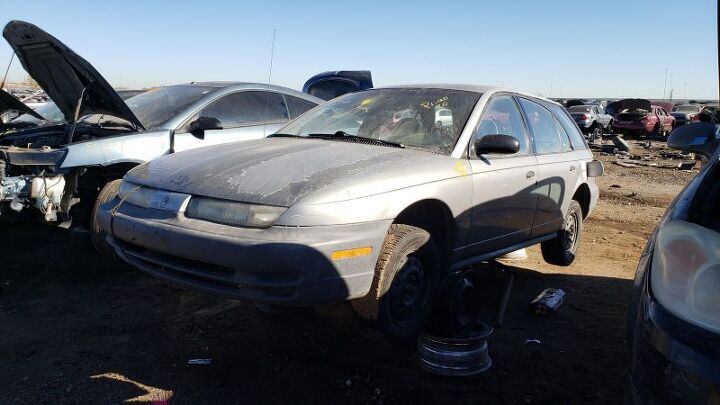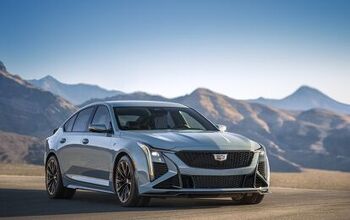Junkyard Find: 1996 Saturn SW1 Wagon With Manual Transmission

We’ve had back-to-back oddball three-pedal cars in this series ( a Suzuki Forenza and non-SHO Taurus), so let’s make it three weeks in a row with today’s Junkyard Find! Saturn S Series cars were always cheaper with manual transmissions, but nearly every Saturn wagon shopper insisted on an automatic. I knew I’d find a manual Saturn SW if I kept searching junkyards, though, and here it is: a low-end ’96 with single-cam engine, Ignore Me Silver paint, and a 5-on-the-floor manual.
The 1996 SW2 came with a 124-horsepower twin-cam engine, better tires and suspension, plus a bunch of appearance and comfort items. The SW1 got this 100-horsepower single-cam engine.
The base manual transmission made every Saturn model significantly cheaper in 1996; MSRP for a 5-speed SW1 was $11,995, with the price going up to $12,825 if you insisted on the four-speed automatic (that’s about $20,230 and $21,630 in 2020 dollars, respectively).
So, the original purchaser of this car saved $830 by getting a manual transmission … then turned around and spent $920 on air conditioning. We’ll never know if that person just preferred to drive a three-pedal wagon or just preferred refrigerated air to an automatic and could afford just one of the two.
It turns out that a Saturn SC/SL/SW with the DOHC engine and manual transmission can get around a road course very, very quickly in the hands of a good driver, and so we see plenty of these machines in 24 Hours of Lemons. I’d say that an SC2 will beat a same-year Integra, given equal driver skill and the same tires. The SL sedan weighs about 60 pounds more than the SC coupe, and the wagon scales in at 220 additional pounds, so I had to dig through a lot of race photos to find a shot of a sedan on a track (sorry, wagon fiends, I have no photos of Saturn SWs on a track).
Strangely, this car has the $350 power-locks option but not power windows. The ’96 SW had a $1,940 option package that included A/C, power locks/windows, cruise control, and a few other goodies.
It made it just a bit past the 175k-mile mark before being forcibly retired from service.
When your car craps out on a Colorado highway and gets left on the shoulder, the CSP will throw one of these red tags on it a couple days prior to towing. During hot summer days, you’ll see plenty of these red tags fluttering on abandoned vehicles on the uphill sides of steep mountain grades; some of those 10,000-plus-foot passes here are real hooptie-killers.
This car still has the CSP impound yard’s paint-pen lettering from September. The fines and fees to recover it would have been far greater than the value of a 24-year-old Saturn, and no used-car lot can move a high-mile Detroit econo-wagon with three pedals these days. Next stop: junkyard!
People are always lookin’ at this car (when it’s driven by a scary clown and packed full of scary stuffed animals).
You could lease a new Saturn for just 24,000 yen!
I think the Japanese-market Saturns sold about as well as the Toyota Cavalier.
For links to more than 2,000 additional Junkyard Finds, visit the Junkyard Home of the Murilee Martin Lifestyle Brand™.

Murilee Martin is the pen name of Phil Greden, a writer who has lived in Minnesota, California, Georgia and (now) Colorado. He has toiled at copywriting, technical writing, junkmail writing, fiction writing and now automotive writing. He has owned many terrible vehicles and some good ones. He spends a great deal of time in self-service junkyards. These days, he writes for publications including Autoweek, Autoblog, Hagerty, The Truth About Cars and Capital One.
More by Murilee Martin
Latest Car Reviews
Read moreLatest Product Reviews
Read moreRecent Comments
- Lou_BC Well, I'd be impressed if this was in a ZR2. LOL
- Lou_BC This is my shocked face 😲 Hope formatting doesn't fook this up LOL
- Lou_BC Junior? Would that be a Beta Romeo?
- Lou_BC Gotta fix that formatting problem. What a pile of bullsh!t. Are longer posts costing TTAC money? FOOK
- Lou_BC 1.Honda: 6,334,825 vehicles potentially affected2.Ford: 6,152,6143.Kia America: 3,110,4474.Chrysler: 2,732,3985.General Motors: 2,021,0336.Nissan North America: 1,804,4437.Mercedes-Benz USA: 478,1738.Volkswagen Group of America: 453,7639.BMW of North America: 340,24910.Daimler Trucks North America: 261,959




















































Comments
Join the conversation
I worked on many of these S-series cars over the years and always appreciated how durable they seemed to be, likely owing to their simplicity. For the manuals, you could change a clutch with the transmissions still in the car! Just unbolt it, tilt the tansaxle to the side with a jack under it, and out she comes! The Achilles heel of these cars was the automatic transmission which suffered a few life-ending maladies. Otherwise they were rock solid, and a manual one would run forever and never have rust around the fender edges like every other car of this era (and even today!). Many customers drove these into the ground and they made perfect sense used for young drivers. Unfortunately, the parts supplies have finally dried up, so if you need anything beyond brakes and filters, it just isn't made anymore. My friend's high-volume shop regularly performs last rites on these and Suzukis because you can't get the parts to fix them. Friend of mine just found one cheap for his son and it pained me to tell him not to buy it for this reason.
The Mrs. had a 96 5-speed SL when we met. Wasn't quick but was entertaining enough to drive. About 80K in I noticed the coolant overflow tank contained what looked to be a chocolate shake. Got a free cracked head replacement out of the dealer. One of those "We know, but Tyler Durden determined the cost of fixing every car was too much" service things. She eventually upgraded to a Lexus ES but if the neighbor kid who'd bought it had avoided getting t-boned it'd likely still be running (at a modest pace).